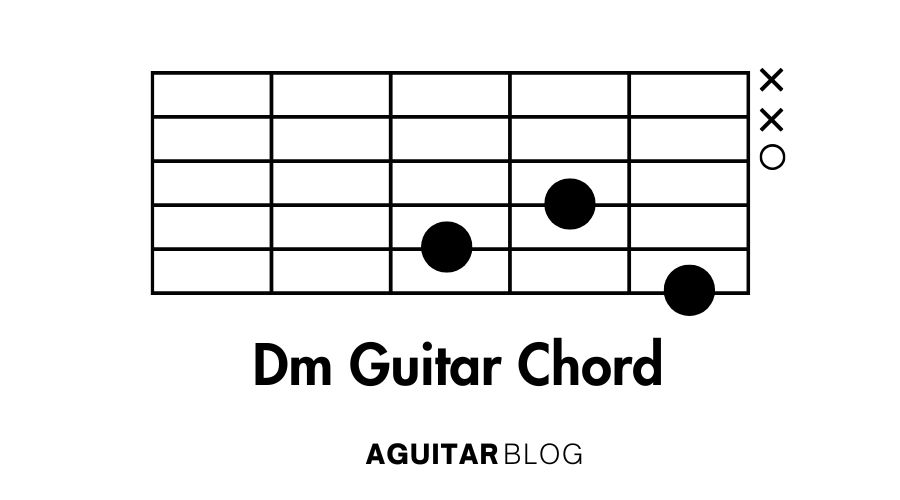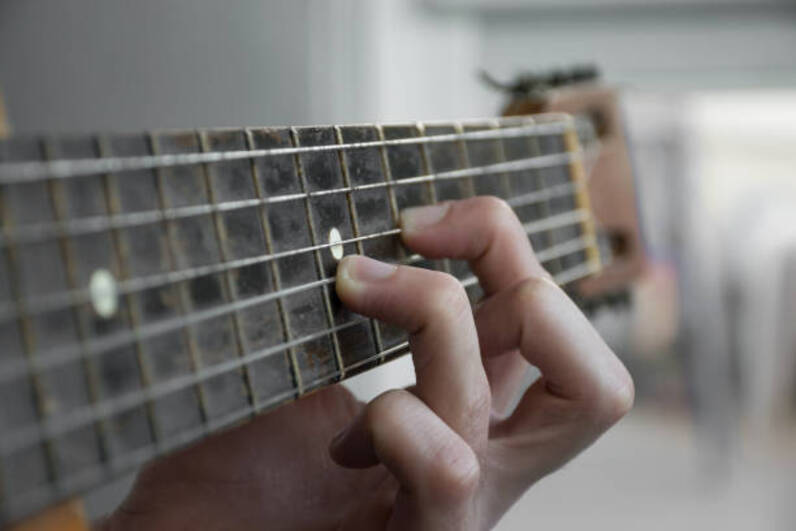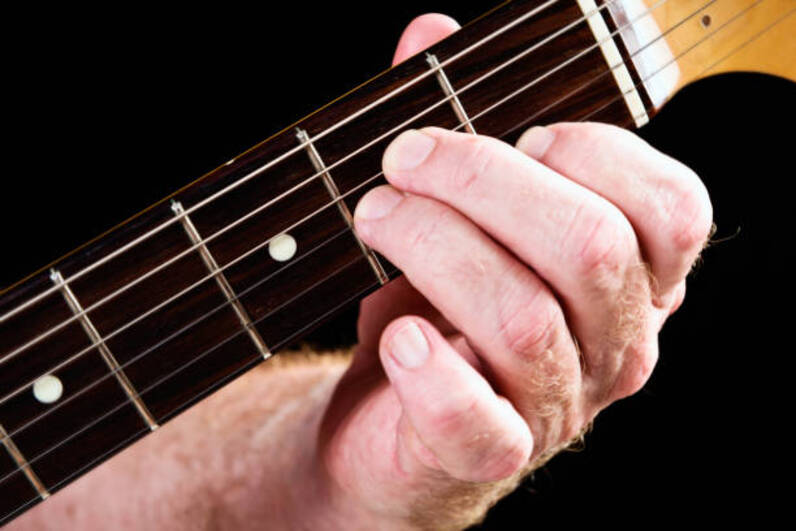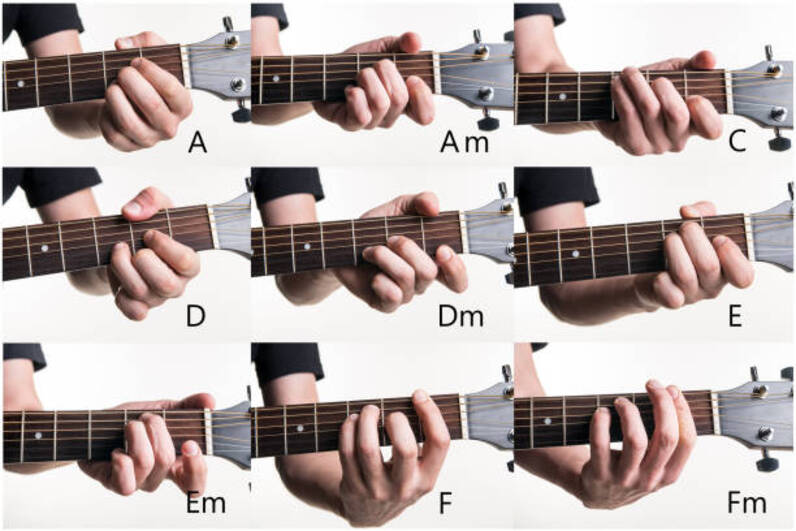Start your guitar journey with the Dm guitar chord, also known as the D minor chord. This foundational chord is full of emotion and is commonly used in various music genres, from classical to rock. Easy to learn but captivating in sound, the Dm chord is an excellent choice for beginners. Discover how to play this chord easily and effectively, and quickly elevate your musical skills to new heights.
What is a Dm Guitar Chord?
A Dm guitar chord, or D minor chord, is a chord that consists of the notes D, F, and A. It produces a melancholic, somber sound often used in various music genres like classical, rock, and pop. The Dm chord is essential for beginners to learn as it helps develop finger strength and dexterity.
How to Play the Dm Guitar Chord
Here’s a chord diagram for reference:

- Place your index finger on the 1st fret of the high E (1st) string.
- Place your middle finger on the 2nd fret of the G (3rd) string.
- Place your ring finger on the 3rd fret of the B (2nd) string.
- Strum from the D (4th) string down, ensuring the A (5th) and low E (6th) strings are muted.
Video Tutorial
Common Mistakes and Tips for Playing the Dm Guitar Chord
Common Mistakes

Incorrect Finger Placement:
- Ensure your index finger is firmly pressing down on the 1st fret of the high E (1st) string.
- Make sure your middle finger is correctly positioned on the 2nd fret of the G (3rd) string.
- Place your ring finger securely on the 3rd fret of the B (2nd) string.
Muting Other Strings:
- Avoid touching the high E (1st) string with your middle or ring finger.
- Ensure your fingers are not touching adjacent strings to prevent unwanted muting.
Insufficient Pressure:
- Press down firmly enough on each string to produce a clear, ringing sound.
- Avoid pressing too lightly, which can result in a muted or buzzy sound.
Improper Hand Position:
- Keep your thumb positioned behind the neck of the guitar for better leverage and control.
- Avoid letting your thumb wrap around the top of the neck.
Strumming Incorrect Strings:
Strum from the D (4th) string down, and make sure not to strum the A (5th) and low E (6th) strings.
Tips for Playing the Dm guitar Chord

Finger Placement Practice:
- Place your fingers one at a time and check the sound of each string individually to ensure clarity.
- Practice transitioning to and from the Dm chord with other chords to improve your dexterity.
Use the Fingertips:
- Press the strings with the tips of your fingers to avoid muting adjacent strings.
- Keep your fingers as perpendicular to the fretboard as possible.
Hand Position:
- Keep your wrist relaxed and slightly bent to maintain proper finger positioning.
- Ensure your fingers are hovering close to the frets to minimize the pressure needed.
Strumming Practice:
- Practice strumming slowly and evenly, focusing on hitting the correct strings.
- Use a metronome to keep a steady rhythm and gradually increase your speed as you become more comfortable.
Regular Practice:
- Set aside regular practice sessions to reinforce muscle memory.
- Start with short, focused practice sessions and gradually increase the duration as you improve.
By avoiding these common mistakes and following these tips, you’ll be able to play the Dm chord more accurately and confidently.
Dm (D Minor) Chord Variations
- Dm7 (D Minor 7): Adds a bluesy feel with the 7th note (C).
- Dm9 (D Minor 9): Complex jazz flavor with the 9th note (E).
- Dm6 (D Minor 6): Brighter tone incorporating the 6th note (B).
- Dm(add9): Enriched sound with the 9th note (E) and no 7th.
- Dm/A (D Minor with A Bass): Alters harmonic depth by placing A as the ba231ss note.
These Dm chord variations provide versatility and depth, suitable for various musical styles and arrangements. Mastering these variations enhances your guitar playing and creative expression.
Chord Progressions and Songs Featuring the Dm Guitar Chord

The Dm (D minor) chord is versatile and adds a rich, emotive quality to chord progressions and songs across various music genres. Here are some common chord progressions and examples of songs that feature the Dm chord:
Common Chord Progressions
Dm – Am – G – C: This progression is popular in pop and rock music. It features the Dm chord as a minor chord in a sequence that resolves nicely back to the tonic (C major).
Dm – Bb – F – C: Often used in jazz and blues, this progression utilizes the Dm chord in a more complex harmonic context, leading into a major resolution.
Dm – A7 – Dm – Gm: A minor blues progression, common in blues and rock music, using the Dm chord to create a moody and soulful atmosphere.
Songs Featuring the Dm Chord
“Hotel California” by Eagles
Uses a Dm chord in the iconic intro and throughout the song to create a haunting and memorable atmosphere.
“Creep” by Radiohead
Features a Dm chord progression that underlines the song’s melancholic and introspective theme.
“Let It Be” by The Beatles
Incorporates the Dm chord in the verse sections, adding a touch of introspection to the uplifting message of the song.
“Someone Like You” by Adele
Uses a Dm chord progression in the chorus to evoke a sense of longing and emotion.
Tips for Practicing
- Start Slowly: Practice each chord progression slowly and focus on smooth transitions between chords.
- Use a Metronome: Maintain a steady rhythm to improve timing and accuracy.
- Experiment: Explore variations of the progressions by adding or substituting chords to create your unique sound.
By incorporating these progressions and songs into your practice routine, you’ll not only improve your ability to play the Dm chord but also deepen your understanding of its versatility in music composition.
Related Chords to Dm Guitar Chord

Explore these related chords to Dm (D minor) for enhanced musical versatility:
- Am (A minor)
- Em (E minor)
- G (G major)
- F (F major)
- C (C major)
These chords complement Dm in creating diverse chord progressions and musical arrangements.
Conclusion
Mastering the Dm (D minor) guitar chord opens up a world of musical possibilities, from heartfelt ballads to energetic rock tunes. Whether you’re a beginner or seasoned guitarist, the Dm chord’s melancholic sound adds depth and emotion to your playing.
By practicing the Dm chord and its variations, you’ll not only enhance your finger dexterity and chord knowledge but also broaden your musical repertoire. Experiment with different chord progressions and explore songs that feature the Dm chord to further refine your skills.
Keep strumming, practicing transitions, and exploring new melodies with the Dm chord. With dedication and persistence, you’ll soon integrate this versatile chord into your musical journey, creating captivating and expressive guitar compositions.
Start your journey with the Dm chord today and discover the endless possibilities it brings to your guitar playing.